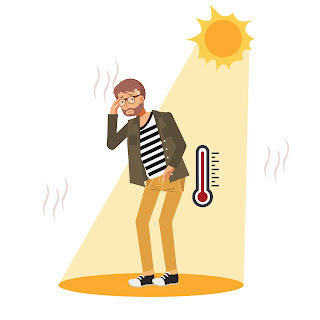Can heat stroke kill you?
Heat stroke:
Heat stroke (or overheating) isn’t something that happens to everyone, but it does happen, particularly if you have never been properly exposed to the sun or have a lack of vitamin D. The signs of heatstroke might vary, so if you suspect you’re suffering from one of these symptoms below, please call 911 immediately!
The warning signs of heatstroke are: extreme shivering, rapid breathing, shortness of breath, nausea/vomiting, dizziness or lightheadedness, confusion, dry mouth, blurred vision, loss of consciousness, and trouble walking. Symptoms may also include low blood pressure, swelling of the face and extremities. The risk of this condition increases with higher temperatures and can be fatal for some people! Signs of cardiovascular collapse may develop as well. If you are not sure whether your heart has stopped beating or has already shut off completely and is unable to speak, or is experiencing chest pain, numbness or tingling in an arm or leg, then take yourself into emergency care right away if any of those symptoms persist! It should also be noted that even if you appear to be experiencing only heat stroke symptoms, dehydration or heat exhaustion may have similar effects and will require medical attention.
Symptoms of overheating can present themselves any time during the day. Although temperature extremes are more common at night than during the daytime, excessive body heat can accumulate over longer periods of time. This increase in heat can cause the following consequences: Increased body weight; Muscle cramps, weakness, fatigue, headache, sore throat, headaches, vomiting; Fatigue & irritability; Changes in mental activity; Skin irritation, itching, burns, blisters, rashes. A person with a fever develops high fever, low energy levels, and a feeling of being “out of control.” As they continue to warm up and cool down, their body becomes exhausted and physically weak. In order to avoid developing heatstroke, try to keep a few things in mind: Have a good supply of fresh air and shade where possible; Keep a cooler or room with a fan running; Eat plenty of liquids before going outside; Drink fluids when you sweat; Avoid strenuous exercise; Seek out hot water or other drinks without sugar or artificial sweeteners. Some natural remedies to help cool yourself down during heat exposure are suggested by many physicians. These are especially helpful for children with cancer that is on chemotherapy and radiotherapy, older adults who get frequent sunburns, or babies and infants who are always outdoors in direct sunlight throughout the day. They encourage individuals to maintain a minimum body temperature of about 95 degrees Fahrenheit (35.5C) all the time, for up to four hours, during summer, winter, or through exposure to seasonal conditions, such as extended humidity or dust storms. People with certain underlying medical conditions, including diabetes, high cholesterol, high blood pressure, HIV and AIDS, and chronic kidney disease, may be at increased risk of dying from heat stroke. High blood pressure and elevated fasting insulin levels in some patients with type 2 diabetes increase the risks of heat-related fatalities. Extreme stress and the use of drugs like cocaine can worsen the situation, often leading to seizures and a variety of harmful side effects. Stress, drug abuse and depression can all contribute to a severe form of heat stroke called nonfatal hyperthermia. Nonfatal hyperthermia is usually due to extreme heat exposure, a serious infection, illness, or injury. Patients can become extremely unwell and die from exposure to cold drafts and hypothermia, which occurs when there are inadequate blood vessels which cannot transport enough oxygen and nutrients or have lost its normal function due to damage. Severe and sudden drops in blood pressure, muscle cramping, and a drop in blood sugar. Shortness of breath with no pulse. Heart failure and cardiomyopathy. The most severe symptoms of heat stroke will depend on how fast and how much of the individual’s core body temperature rises above 99 degrees F (37 degrees C). While the individual’s overall physical state may remain unchanged, the rate at which it rises above 100 degrees F (37 degrees C) may change significantly, resulting in different symptoms across different areas of the body. Many of these symptoms include: Paleness and general feeling of warmth, nausea or vomiting, diarrhea, abdominal discomfort. Fever and chills. Nausea / vomiting. Cardiac arrest, coma, or internal bleeding from tissue damage. Severe skin rash.


Comments
Post a Comment